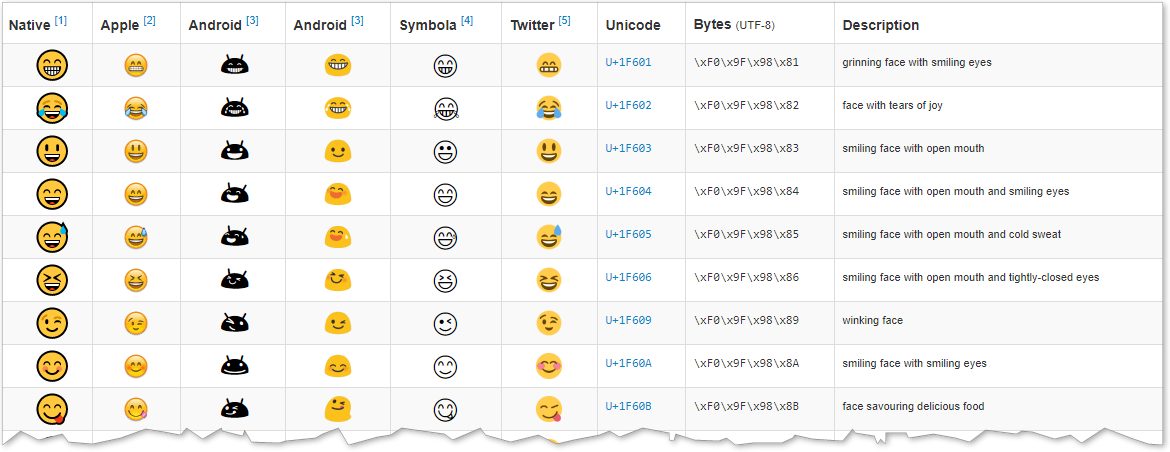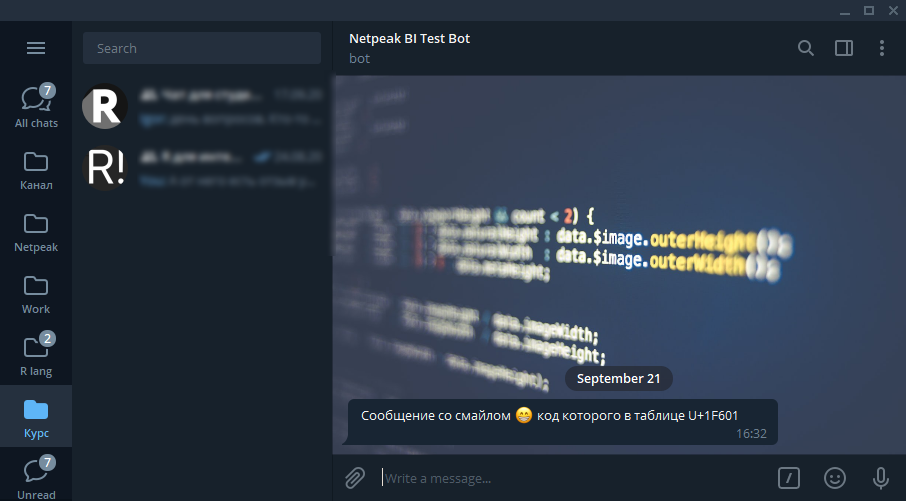يتزايد جمهور Telegram بشكل كبير كل يوم ، ويتم تسهيل ذلك من خلال راحة المرسل ووجود القنوات والمحادثات وبالطبع القدرة على إنشاء برامج الروبوت.
يمكن استخدام الروبوتات لأغراض مختلفة تمامًا ، من أتمتة التواصل مع عملائك إلى إدارة مهامك الخاصة.
في الواقع ، من خلال الروبوت ، يمكنك استخدام telegram لإجراء أي عمليات: إرسال البيانات أو طلبها ، وتشغيل المهام على الخادم ، وجمع المعلومات في قاعدة بيانات ، وإرسال رسائل البريد الإلكتروني ، وما إلى ذلك.
أخطط لكتابة سلسلة من المقالات حول كيفية العمل مع Telegram bot API في R وكتابة برامج الروبوت لتلبية احتياجاتي.

في هذا المقال الأول ، سنكتشف كيفية إنشاء روبوت برقية وإرسال الإشعارات في برقية باستخدامه.
نتيجة لذلك ، سيكون لدينا روبوت يقوم بفحص حالة آخر تنفيذ لجميع المهام في برنامج جدولة مهام Windows ، ويرسل إليك إشعارات في حالة فشل بعضها.
, , , telegram.bot, , , .
" telegram R"
:
I can help you create and manage Telegram bots. If you're new to the Bot API, please see the manual (https://core.telegram.org/bots).
You can control me by sending these commands:
/newbot - create a new bot
/mybots - edit your bots [beta]
Edit Bots
/setname - change a bot's name
/setdescription - change bot description
/setabouttext - change bot about info
/setuserpic - change bot profile photo
/setcommands - change the list of commands
/deletebot - delete a bot
Bot Settings
/token - generate authorization token
/revoke - revoke bot access token
/setinline - toggle inline mode (https://core.telegram.org/bots/inline)
/setinlinegeo - toggle inline location requests (https://core.telegram.org/bots/inline#location-based-results)
/setinlinefeedback - change inline feedback (https://core.telegram.org/bots/inline#collecting-feedback) settings
/setjoingroups - can your bot be added to groups?
/setprivacy - toggle privacy mode (https://core.telegram.org/bots#privacy-mode) in groups
Games
/mygames - edit your games (https://core.telegram.org/bots/games) [beta]
/newgame - create a new game (https://core.telegram.org/bots/games)
/listgames - get a list of your games
/editgame - edit a game
/deletegame - delete an existing game /newbot.
BotFather .
BotFather, [25.07.20 09:39]
Alright, a new bot. How are we going to call it? Please choose a name for your bot.
Alexey Seleznev, [25.07.20 09:40]
My Test Bot
BotFather, [25.07.20 09:40]
Good. Now let's choose a username for your bot. It must end in `bot`. Like this, for example: TetrisBot or tetris_bot.
Alexey Seleznev, [25.07.20 09:40]
@my_test_bot , bot.
, :
Done! Congratulations on your new bot. You will find it at t.me/my_test_bot. You can now add a description, about section and profile picture for your bot, see /help for a list of commands. By the way, when you've finished creating your cool bot, ping our Bot Support if you want a better username for it. Just make sure the bot is fully operational before you do this.
Use this token to access the HTTP API:
123456789:abcdefghijklmnopqrstuvwxyz
For a description of the Bot API, see this page: https://core.telegram.org/bots/api API , 123456789:abcdefghijklmnopqrstuvwxyz.
R
Telegram Bot API R telegram.bot.
R install.packages(), install.packages("telegram.bot").
:
library(telegram.bot)R Telegram
Telegram , @my_test_bot.
, " ". , id .
R .
library(telegram.bot)
#
bot <- Bot(token = "123456789:abcdefghijklmnopqrstuvwxyz")
#
print(bot$getMe())
# , ..
updates <- bot$getUpdates()
#
# :
chat_id <- updates[[1L]]$from_chat_id() Bot(), .
, , . telegram.bot : R_TELEGRAM_BOT___. __ , R_TELEGRAM_BOT_My Test Bot.
, . ( path.expand("~")) .Renviron. file.edit(path.expand(file.path("~", ".Renviron"))).
.
R_TELEGRAM_BOT___=123456789:abcdefghijklmnopqrstuvwxyz bot_token(), .. :
bot <- Bot(token = bot_token("My Test Bot")) getUpdates() , .. . from_chat_id(), , . .
id getUpdates() . , , .
updates[[1L]]$message$from$id
[1] 000000000
$is_bot
[1] FALSE
$first_name
[1] "Alexey"
$last_name
[1] "Seleznev"
$username
[1] "AlexeySeleznev"
$language_code
[1] "ru", , . sendMessage(), , , . Markdown HTML parse_mode.
#
bot$sendMessage(chat_id,
text = ", * * __",
parse_mode = "Markdown"
)Markdown :
- *:
- :
* * - :
- :
- :
- :
__ - :
- :
- , , — `:
- : ` `
- :
HTML :
HTML , , , <></>.
- <> —
- </> —
HTML
<b>—
- :
<b> </b>
- :
<i>—
- :
<i></i> - :
- :
- <code> —
- : <code> </code>
- :
:
#
bot$sendPhoto(chat_id,
photo = "https://telegram.org/img/t_logo.png"
)
#
bot$sendAudio(chat_id,
audio = "http://www.largesound.com/ashborytour/sound/brobob.mp3"
)
#
bot$sendDocument(chat_id,
document = "https://github.com/ebeneditos/telegram.bot/raw/gh-pages/docs/telegram.bot.pdf"
)
#
bot$sendSticker(chat_id,
sticker = "https://www.gstatic.com/webp/gallery/1.webp"
)
#
bot$sendVideo(chat_id,
video = "http://techslides.com/demos/sample-videos/small.mp4"
)
# gif
bot$sendAnimation(chat_id,
animation = "https://media.giphy.com/media/sIIhZliB2McAo/giphy.gif"
)
#
bot$sendLocation(chat_id,
latitude = 51.521727,
longitude = -0.117255
)
#
bot$sendChatAction(chat_id,
action = "typing"
).. sendPhoto() , ggplot2.
Emoji
, Emoji.

Unicode. , U+ \U000. .. , U+1F601, R — \U0001F601.
:
bot$sendMessage(chat_id,
' \U0001F601 U+1F601'):

Windows, ,
Windows taskscheduleR, dplyr.
#
install.packages(c('taskscheduleR', 'dplyr'))
#
library(taskscheduleR)
library(dplyr) taskscheduler_ls() . filter() dplyr , 0, , 267011, , .
#
task <- task <- taskscheduler_ls() %>%
filter(! `Last Result` %in% c("0", "267011") &
`Scheduled Task State` == "Enabled" &
Status != "Running") %>%
select(TaskName) %>%
unique() %>%
unlist() %>%
paste0(., collapse = "\n") task , , Telegram.
, :
filter()— ,select()—unique()—unlist()—paste0()— , , ..\n.
— .
bot$sendMessage(chat_id,
text = task,
parse_mode = "Markdown"
), :
#
library(telegram.bot)
library(taskscheduleR)
library(dplyr)
#
bot <- Bot(token = "123456789:abcdefghijklmnopqrstuvwxyz")
#
chat_id <- 123456789
#
task <- taskscheduler_ls() %>%
filter(! `Last Result` %in% c("0", "267011") &
`Scheduled Task State` == "Enabled" &
Status != "Running") %>%
select(TaskName) %>%
unique() %>%
unlist() %>%
paste0(., collapse = "\n")
#
if ( task != "" ) {
bot$sendMessage(chat_id,
text = task,
parse_mode = "Markdown"
)
}.
, , , .
, id . configr.
[telegram_bot]
; ,
chat_id=12345678
bot_token=123456789:abcdefghijklmnopqrstuvwxyz"library(configr)
#
config <- read.config('C:/__/config.cfg', rcmd.parse = TRUE)
bot_token <- config$telegram_bot$bot_token
chat_id <- config$telegram_bot$chat_id, check_bot.R. , :
- Path R, Windows :
C:\Program Files\R\R-4.0.2\bin. - bat ,
R CMD BATCH C:\rscripts\check_bot\check_bot.R.C:\rscripts\check_bot\check_bot.RR . - Windows , .
, , telegram.
Windows, , , .. R .